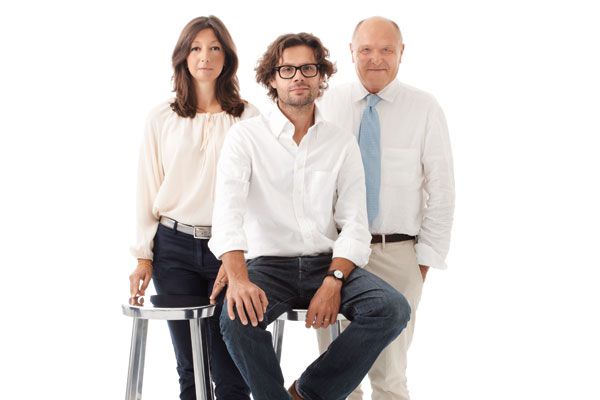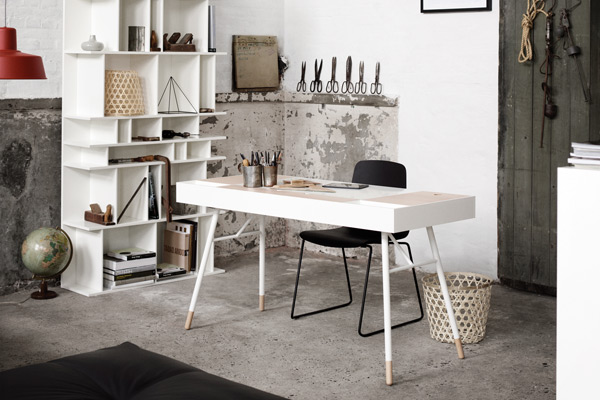One of Italy’s most progressive design companies is marking a new chapter in its design history with its exploration of traditional materials.

July 9th, 2015
It used to be that a visit to Magis’ stand at the annual Salone del Mobile in Milan would be like visiting a plastic playground for adults. The company, founded in 1976 by Eugenio Perazza, had carved a niche for itself by experimenting with various plastic moulding techniques – air moulding, injection moulding, rotation moulding, et cetera – for its products.
Over the years, it started to incorporate different materials into its repertoire, but most still recognised Magis for its work in plastic technology. Of late, however, that impression is changing.
While products such as the Steelwood chair by Ronan and Erwan Bouroullec (2007) and the Déjà-Vu table by Naoto Fukasawa (2008) were earlier departures from the plastic material, it wasn’t till 2011 that a more significant shift started to show, signalled by pieces such as Jaime Hayon’s Piña chair. The chair has a steel wire-frame seat that cradles upholstered cushions while supported by legs in solid beech, and not a piece of plastic in sight. Here was a Magis that we weren’t familiar with – a more traditional, conservative Magis, or so we thought.
Perhaps it was a move toward creating more accessible furniture during a sluggish economic period, we speculated. In reality, it was a strategic move of a different kind.
“We were one of the first companies to have chairs in plastic. But around 10 years ago we found that every other company was doing plastics,” says Alberto Perazza, second-generation Co-Managing Director of the family-owned business. That’s what triggered the shift from plastics to combinations of plastic and wood, or metal and wood.
“We continue to make chairs in plastic,” Perazza says, “but only when the use of plastic brings more value to the product. We found that this is usually associated with combining it with other materials.” In essence, the company had simply taken its exploratory efforts in a different direction – a more sophisticated and we dare say more thoughtful direction.
Perazza cites the Tom & Jerry stools by Konstantin Grcic as prime examples. The stools are made of solid beech wood with a plastic joint and a height-adjustable mechanism in the middle. “For this project, we thought it was more interesting to use plastic for the joints rather than making it entirely with wood,” says Perazza.
Both the Piña chair and Tom & Jerry stools were released in 2011. Since then, Magis has gone on to explore other materials – even more traditional materials such as wrought iron for products like the recently released Officina range by Ronan and Erwan Bouroullec. “It’s a simple idea. It’s not a revolutionary idea, but it’s very interesting,” says Perazza.
It’s no easy feat, grappling with traditional techniques and pushing their limits for designs that need to feel fresh and contemporary. This means going deep with specific production methods. In this respect, Magis’ formula for furniture production is a shoo-in.
From day one, Magis has never owned a factory. From a cost-savings point of view, it keeps overheads low. But this has always been secondary to the creative freedom it affords the company.
“A factory is usually related to a specific material and technology. Being independent of a factory allows us to go in different directions, experiment with different materials and technologies – not only plastics, but metals, die-cast aluminium, wood processing, et cetera,” Perazza explains.
The decision to be factory-free is paying off in a big way now that Magis is actively exploring various materials, but it is not without risks. For a company that invests significantly in research and development, sharing its findings with an external manufacturer is risky. After all, there is nothing to stop the manufacturer from sharing with its newfound know-how with a third party and Perazza is not ignorant of the fact.
“Yes, it’s possible, but we want to focus on a limited number of production partners to grow together. We try to build strong partnerships with our suppliers. These are partnerships where both parties learn, and if new know-how is discovered, it’s for both our benefits, and it can be used for future project developments with the same suppliers.”
Collaboration has always been part of the Magis DNA and it shows – especially in the way the company works with designers. While the elder Perazzo, age 75 this year, focuses fully on design within the company, he is not alone in the creation of each project. The younger Perazzo, engineers, model makers and of course, the designer of the product are all part of a collaborative design effort.
“We like to guide [the designers] and be fully involved in the design process. We believe that good design comes from a process of dialogue between the company and the designers,” Perazzo says.
Every once in a while, something magical happens and a product like Chair_One by Grcic is born. Perazzo shares that everyone had doubts about whether it would be a successful product. In fact, it took at least three years before the chair, released in 2003, started selling well on the market. Today, it remains one of Magis’ top five bestsellers and is one of the most recognisable contemporary designs. It is one of the true icons of contemporary design.
But Magis is not out to create icons. “It’s not easy to always be on the edge, experimenting with new things, new directions,” Perazza frankly shares. What does the company want to do? Design products that “bring some value, some fun, some distinctiveness to an environment – a home, an office, a garden.”
Magis
magisdesign.com
Xtra
xtra.com.sg
A searchable and comprehensive guide for specifying leading products and their suppliers
Keep up to date with the latest and greatest from our industry BFF's!

Channelling the enchanting ambience of the Caffè Greco in Rome, Budapest’s historic Gerbeaud, and Grossi Florentino in Melbourne, Ross Didier’s new collection evokes the designer’s affinity for café experience, while delivering refined seating for contemporary hospitality interiors.

Suitable for applications ranging from schools and retail outlets to computer rooms and X-ray suites, Palettone comes in two varieties and a choice of more than fifty colours.

In the pursuit of an uplifting synergy between the inner world and the surrounding environment, internationally acclaimed Interior Architect and Designer Lorena Gaxiola transform the vibration of the auspicious number ‘8’ into mesmerising artistry alongside the Feltex design team, brought to you by GH Commercial.

With a sophisticated and contemporary aesthetic, Cupertino from BoConcept is much more than just a mere desk.

Available now for online readers, the 82nd issue of Indesign largely focuses on hospitable design, it’s trends and it’s importance.
The internet never sleeps! Here's the stuff you might have missed

The AIA Alta Wellness Haven offers the complete package for health and wellbeing away from the busy city life in Hong Kong and does it through a stellar interior design.

An outstanding line-up of participants will contribute to a beautifully curated exhibition in Thailand that delves deep into the collective thinking of architecture in our region and helps set a progressive agenda for the future of design.